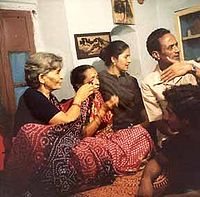
Vijaya Mulay
Encyclopedia
Vijaya Mulay born 16 May 1921 in Bombay, India
is a documentary filmmaker, film historian
, writer
, educationist and researcher
.
Her close friendships with Satyajit Ray
, Louis Malle
, Mrinal Sen
and other film personalities have given her a unique perspective into Indian cinema and influenced her work. Her body of work has shaped how India is viewed by Indian and non-Indian filmmakers.
 In 1940, Vijaya accompanied her husband when he was transferred to Patna
In 1940, Vijaya accompanied her husband when he was transferred to Patna
, Bihar
. Compared to the cosmopolitan Bombay the pre-independence Patna seemed to her like a place from another universe. But Patna University allowed women to study privately and Vijaya enrolled for a Bachelors degree.
English films were shown half price on Sunday mornings at the city theatres known as Bioscopes. Vijaya began her love affair with the medium and started grasping the idiom of cinema.
 In 1946 she won a state scholarship to study in University of Leeds
In 1946 she won a state scholarship to study in University of Leeds
, UK for Master’s degree in Education.
While there, Vijaya realised that the ordinary Britisher was hardly like the English “Burra Saabs” (Great Masters) back in India.
From an interview with Vijaya Mulay on her days in the UK - I had gone to Britain, with an anti-colonial distaste for the British people and with the sole purpose of studying for my degree. I was on my guard, ready to take offence at the slightest insult or remark derogatory to me or to India, whether imagined or real. But I soon found out that the ordinary English people were hardly like the ‘Burra Sahibs’ that one saw back home.
On post-war cinema in UK - The Workers’ Unity Theatre played to full houses. Films from the Soviet Union and Eastern Europe ran often. I saw film classics, experimental films, and socialist cinema. I also gained a better perspective and understanding of the cinematic art by joining the university film society. Film viewing, once a casual pastime, became my serious passion.
when Government of India appointed her as an Education Officer. Vijaya also found time to open Delhi Film Society and in 1959, eight film societies came together to form Federation of Film Societies of India
with Satyajit Ray
as the founding president and Vijaya Mulay and the critic Chidanand Das Gupta as joint secretaries.
After the passing away of Satyajit Ray, Vijaya was appointed as the President of FFSI.
 In 1962 Vijaya was deputed to Bombay to work at the Central Board of Film Censors.
In 1962 Vijaya was deputed to Bombay to work at the Central Board of Film Censors.
From an interview with Vijaya Mulay - For five years I sat as the presiding officer with other four members from an approved panel that judged Indian and foreign films. It gave me an insight into the biases of panellists that coloured their judgement of a film’s suitability for public viewing. My work with the Film Censor Board proved a mixed blessing. I had to see films that ordinarily I would have walked out of in sheer boredom.
In 1966 Vijaya was transferred to Calcutta and the following year Louis Malle came to the city with a French film delegation. When they met Malle had an instant dislike towards the woman censor officer. The dislike blossomed into a close friendship that lasted till Louis Malle's passing away in 1995.
Both Satyajit Ray and Louis Malle helped Vijaya in making her first film - 'The Tidal Bore' (about the 15 feet tidal bore
coming from Bay of Bengal
like a wall of water on the Hooghly River). Malle sent negative stock from France and Ray voiced the commentary.
Government of India selected 'The Tidal Bore' as the official entry to the Mannheim Film Festival. Later Film Federation of India screened the film in theaters across the country.
satellite (ATS-6 had one video and two audio channels) UNICEF hired Vijaya to produce test modules for children in the 6 to 9 age group. In 1975, Vijaya was asked to head the CET - Center for Educational Technology to prepare educational films for broadcast to over 2400 villages in rural districts and programming in 4 languages.
Ek Anek Aur Ekta, the 1974 animation film Scripted and Directed by Vijaya Mulay and Produced by Center for Educational Technology is very popular amongst the many generations of Indians.
The CET, NCERT projects equipped her to later continue research on the field of education and on using media for development.
After her retirement from NCERT, Vijay took up a benchmark survey of distance education in Indian Universiites and collected data from 23 (out of the 25) universities that were then providing such education. This work was finished in 1983.
The next 3 years, Vijaya worked as the Project Coordinator at the University Grants Commission and was responsible for the program Countrywide Classroom for undergraduates.
while making The River (1951 film)
, and Roberto Rossellini
prompted her to find out what about India excites and motivates the non-Indians, especially the filmmakers.
“From Rajahs and Yogis to Gandhi and Beyond: India in International Cinema” will be published by Seagull, Kolkata and is stated to be released by Seagull books in August 2008.
Excerpt from the first chapter of 'As Others See Us'....
The little Gangotri, from where the river Ganga (the Ganges) emerges is a small rill; it becomes the majestic river Ganga as more rivers join it to expand its basin and flow. My project too has followed a similar path and has become bigger and bigger though unlike Ganga, it is neither majestic nor holy. I look upon this study as a personal journey of a film buff to understand what India meant to different people at different points of time as expressed in films.
India
India , officially the Republic of India , is a country in South Asia. It is the seventh-largest country by geographical area, the second-most populous country with over 1.2 billion people, and the most populous democracy in the world...
is a documentary filmmaker, film historian
Historian
A historian is a person who studies and writes about the past and is regarded as an authority on it. Historians are concerned with the continuous, methodical narrative and research of past events as relating to the human race; as well as the study of all history in time. If the individual is...
, writer
Writer
A writer is a person who produces literature, such as novels, short stories, plays, screenplays, poetry, or other literary art. Skilled writers are able to use language to portray ideas and images....
, educationist and researcher
Researcher
A researcher is somebody who performs research, the search for knowledge or in general any systematic investigation to establish facts. Researchers can work in academic, industrial, government, or private institutions.-Examples of research institutions:...
.
Her close friendships with Satyajit Ray
Satyajit Ray
Satyajit Ray was an Indian Bengali filmmaker. He is regarded as one of the greatest auteurs of 20th century cinema. Ray was born in the city of Kolkata into a Bengali family prominent in the world of arts and literature...
, Louis Malle
Louis Malle
Louis Malle was a French film director, screenwriter, and producer. He worked in both French cinema and Hollywood. His films include Ascenseur pour l'échafaud , Atlantic City , and Au revoir, les enfants .- Early years in France :Malle was born into a wealthy industrialist family in Thumeries,...
, Mrinal Sen
Mrinal Sen
Mrinal Sen is a Bengali Indian filmmaker. He was born on 14 May 1923, in the town of Faridpur, now in Bangladesh in a Hindu family. After finishing his high school there, he left home to come to Calcutta as a student and studied physics at the well-known Scottish Church College and at the...
and other film personalities have given her a unique perspective into Indian cinema and influenced her work. Her body of work has shaped how India is viewed by Indian and non-Indian filmmakers.
Awards and Milestones
- The Government of India honored Vijaya Mulay with the V. Shantaram Award for Lifetime Achievement for documentaries at the Mumbai International Film Festival - MIFF, 2002.
- Vikram Sarabhai Life Time Achievement award for educational communication in 1999.
- President of the Federation of Film Societies of India.
- Led the Indian Educational Technology Mission to the USA in 1975.
- Member Secretary of the Education commission for Goa and other former Portuguese territories in 1962.
- Developed a multimedia package through SITE (Satellite Instructional Television Experiment)for training of more than 48000 primary school teachers. Widely considered to be a path-breaking program in the area of educational technology.
- Several of her films received National awards and awards at International Film Festivals including Delhi, New York, Teheran.
The beginning...Bombay to Patna, Bihar

Patna
Paṭnā , is the capital of the Indian state of Bihar and the second largest city in Eastern India . Patna is one of the oldest continuously inhabited places in the world...
, Bihar
Bihar
Bihar is a state in eastern India. It is the 12th largest state in terms of geographical size at and 3rd largest by population. Almost 58% of Biharis are below the age of 25, which is the highest proportion in India....
. Compared to the cosmopolitan Bombay the pre-independence Patna seemed to her like a place from another universe. But Patna University allowed women to study privately and Vijaya enrolled for a Bachelors degree.
English films were shown half price on Sunday mornings at the city theatres known as Bioscopes. Vijaya began her love affair with the medium and started grasping the idiom of cinema.
Patna to Leeds, UK

University of Leeds
The University of Leeds is a British Redbrick university located in the city of Leeds, West Yorkshire, England...
, UK for Master’s degree in Education.
While there, Vijaya realised that the ordinary Britisher was hardly like the English “Burra Saabs” (Great Masters) back in India.
From an interview with Vijaya Mulay on her days in the UK - I had gone to Britain, with an anti-colonial distaste for the British people and with the sole purpose of studying for my degree. I was on my guard, ready to take offence at the slightest insult or remark derogatory to me or to India, whether imagined or real. But I soon found out that the ordinary English people were hardly like the ‘Burra Sahibs’ that one saw back home.
On post-war cinema in UK - The Workers’ Unity Theatre played to full houses. Films from the Soviet Union and Eastern Europe ran often. I saw film classics, experimental films, and socialist cinema. I also gained a better perspective and understanding of the cinematic art by joining the university film society. Film viewing, once a casual pastime, became my serious passion.
1959, Satyajit Ray and India's first Film Society
Vijaya returned to Patna in 1949 and actively worked in the local film society. In 1954, she moved to New DelhiNew Delhi
New Delhi is the capital city of India. It serves as the centre of the Government of India and the Government of the National Capital Territory of Delhi. New Delhi is situated within the metropolis of Delhi. It is one of the nine districts of Delhi Union Territory. The total area of the city is...
when Government of India appointed her as an Education Officer. Vijaya also found time to open Delhi Film Society and in 1959, eight film societies came together to form Federation of Film Societies of India
Federation of Film Societies of India
The Federation of Film Societies of India was formed in December 1959. This was an association of film societies of Calcutta , Delhi, Bombay , Madras and Patna....
with Satyajit Ray
Satyajit Ray
Satyajit Ray was an Indian Bengali filmmaker. He is regarded as one of the greatest auteurs of 20th century cinema. Ray was born in the city of Kolkata into a Bengali family prominent in the world of arts and literature...
as the founding president and Vijaya Mulay and the critic Chidanand Das Gupta as joint secretaries.
After the passing away of Satyajit Ray, Vijaya was appointed as the President of FFSI.
Film Censor Board of India, Louis Malle and The Tidal Bore

From an interview with Vijaya Mulay - For five years I sat as the presiding officer with other four members from an approved panel that judged Indian and foreign films. It gave me an insight into the biases of panellists that coloured their judgement of a film’s suitability for public viewing. My work with the Film Censor Board proved a mixed blessing. I had to see films that ordinarily I would have walked out of in sheer boredom.
In 1966 Vijaya was transferred to Calcutta and the following year Louis Malle came to the city with a French film delegation. When they met Malle had an instant dislike towards the woman censor officer. The dislike blossomed into a close friendship that lasted till Louis Malle's passing away in 1995.
Both Satyajit Ray and Louis Malle helped Vijaya in making her first film - 'The Tidal Bore' (about the 15 feet tidal bore
Tidal bore
A tidal bore is a tidal phenomenon in which the leading edge of the incoming tide forms a wave of water that travel up a river or narrow bay against the direction of the river or bay's current...
coming from Bay of Bengal
Bay of Bengal
The Bay of Bengal , the largest bay in the world, forms the northeastern part of the Indian Ocean. It resembles a triangle in shape, and is bordered mostly by the Eastern Coast of India, southern coast of Bangladesh and Sri Lanka to the west and Burma and the Andaman and Nicobar Islands to the...
like a wall of water on the Hooghly River). Malle sent negative stock from France and Ray voiced the commentary.
Government of India selected 'The Tidal Bore' as the official entry to the Mannheim Film Festival. Later Film Federation of India screened the film in theaters across the country.
Multimedia, UNICEF and CET/NCERT
When US loaned India its ATS-6ATS-6
ATS-6 was a NASA experimental satellite, built by Fairchild Space and Electronics Division It has been called the world's first educational satellite as well as world's first experimental Direct Broadcast Satellite as part of the Satellite Instructional Television Experiment between NASA and ISRO...
satellite (ATS-6 had one video and two audio channels) UNICEF hired Vijaya to produce test modules for children in the 6 to 9 age group. In 1975, Vijaya was asked to head the CET - Center for Educational Technology to prepare educational films for broadcast to over 2400 villages in rural districts and programming in 4 languages.
Ek Anek Aur Ekta, the 1974 animation film Scripted and Directed by Vijaya Mulay and Produced by Center for Educational Technology is very popular amongst the many generations of Indians.
The CET, NCERT projects equipped her to later continue research on the field of education and on using media for development.
After her retirement from NCERT, Vijay took up a benchmark survey of distance education in Indian Universiites and collected data from 23 (out of the 25) universities that were then providing such education. This work was finished in 1983.
The next 3 years, Vijaya worked as the Project Coordinator at the University Grants Commission and was responsible for the program Countrywide Classroom for undergraduates.
As Others See Us
While going through some of Louis Malle's letters Vijaya realised how India had changed him. Similar experiences of Jean RenoirJean Renoir
Jean Renoir was a French film director, screenwriter, actor, producer and author. As a film director and actor, he made more than forty films from the silent era to the end of the 1960s...
while making The River (1951 film)
The River (1951 film)
The River is a 1951 film directed by Jean Renoir. It was filmed in India and was seminal to the launching of the careers of Satyajit Ray , who assisted on the film, and Subrata Mitra, Ray's cinematographer whom he met during the filming of The River.A fairly faithful dramatization of an earlier...
, and Roberto Rossellini
Roberto Rossellini
Roberto Rossellini was an Italian film director and screenwriter. Rossellini was one of the directors of the Italian neorealist cinema, contributing films such as Roma città aperta to the movement.-Early life:Born in Rome, Roberto Rossellini lived on the Via Ludovisi, where Benito Mussolini had...
prompted her to find out what about India excites and motivates the non-Indians, especially the filmmakers.
“From Rajahs and Yogis to Gandhi and Beyond: India in International Cinema” will be published by Seagull, Kolkata and is stated to be released by Seagull books in August 2008.
Excerpt from the first chapter of 'As Others See Us'....
The little Gangotri, from where the river Ganga (the Ganges) emerges is a small rill; it becomes the majestic river Ganga as more rivers join it to expand its basin and flow. My project too has followed a similar path and has become bigger and bigger though unlike Ganga, it is neither majestic nor holy. I look upon this study as a personal journey of a film buff to understand what India meant to different people at different points of time as expressed in films.

